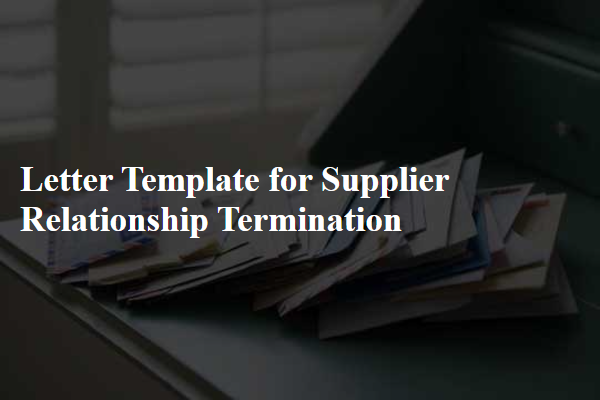Navigating the end of a supplier relationship can be a daunting task, but it doesn't have to be. Whether due to shifting business needs or performance issues, communicating this decision with clarity and professionalism is essential. In this article, we'll explore effective ways to craft a letter that not only delivers the message but also maintains respect for the partnership. So, if you're ready to learn how to communicate your intentions smoothly, keep reading!

Formal greeting and recipient's name
A formal greeting to a supplier, such as "Dear [Supplier's Name]," is typically used to address the individual or organization directly involved in the partnership. The choice of salutation sets the tone for the communication, reflecting professionalism and respect.
Clear statement of termination
Termination of a supplier relationship involves a formal notice to the involved parties, specifying the end of the contractual agreement. A clear statement of termination is essential to avoid misunderstandings. The notice should include the effective date of termination, outlining any outstanding obligations such as payments or inventory returns. It is also prudent to mention the reasons for termination, whether due to performance issues, market changes, or other factors. Additionally, including a reminder of confidentiality obligations, if applicable, reinforces the seriousness of the termination. Clear communication during this process helps maintain professionalism, ensuring that relationships can be preserved for future interactions, if necessary.
Reason for termination
The termination of a supplier relationship can be influenced by multiple factors including consistent delays in product delivery, failure to meet quality standards, or inadequate customer service responses. In instances where a supplier fails to adhere to agreed schedules, such as a pattern of late shipments affecting operations, it undermines the trust essential in business agreements. Additionally, if the supplier provides products that do not comply with the quality benchmarks established during contract negotiations, it can lead to dissatisfaction among clients and potential financial losses. Furthermore, poor communication practices, such as lack of timely updates or unhelpful responses, can erode the collaborative spirit necessary for successful partnerships. Each of these reasons plays a critical role in the decision to terminate a supplier relationship, ensuring a focus on operational efficiency and maintaining high standards for service delivery.
Terms and conditions compliance
In supplier relationships, non-compliance with established terms and conditions can lead to significant business disruptions. The consequences of such breaches may include financial penalties, loss of trust, or the necessity to terminate contracts. Companies must ensure that suppliers adhere to agreed quality standards, delivery schedules, and pricing structures. For instance, a contract violation regarding the supply of raw materials can delay production lines, affecting overall efficiency and revenue generation. Documenting and communicating the reasons for termination is crucial for legal protection and maintaining a professional reputation in the industry. This process often involves outlining specific breaches, referencing contract clauses, and providing appropriate notice periods as per legal obligations.
Contact information for follow-up
Supplier relationship termination can sometimes lead to uncertainty regarding future communications. Providing clear contact information for follow-up can ensure both parties maintain a professional dialogue. Include the name of the primary contact person (such as John Smith, Procurement Manager), direct phone number (e.g., +1-555-123-4567), and an official email address (e.g., john.smith@company.com) for any inquiries or clarifications. Mentioning the company's physical address (for instance, 123 Business Rd, Cityville, CA 90210) will also help facilitate any necessary correspondence related to the conclusion of the partnership. Additionally, provide a timeline for follow-up communications to streamline the process, ensuring that all transitions are conducted smoothly.













Comments